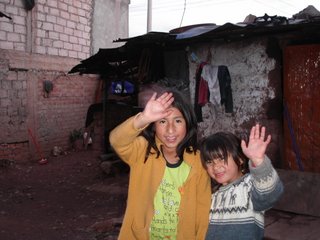The Feast of 12 Plates


Friday, rather than Easter, is the big feast day here. Rather than being content with ham, potatoes, corn, and pie, the meal here is known as the feast of 12 plates and one is expected to serve 12 different dishes. We were graciously invited to the house of some friends for the event. We had a wonderful meal and a wonderful time. The house consisted of a couple of rooms around a small courtyard which had been muddied by the recent rains. The meal was prepared in a small dirt-floor kitchen on some metal burners which were hooked up to an adjacent propane tank. Other than a small table, on which food was prepared, there was no other furnishings and pots and pans which were not in use were stacked on the floor. We ate in the adjoining main room which, unlike the kitchen, had a cement floor and the adobe mud bricks were covered with blue plastic. The room was furnished with a table and chairs and a hutch for dishes. A few snapshots, a poster of the local soccer team, and some pictures from old calendars rounded out the décor. The bathroom was the only other room we visited and was decorated in what perceived to be a functional shambolic style. A water spigot over a cement basin in the courtyard provided water for the household. Houses like this are not uncommon in Cusco and Latin America in general. While I actually prefer adobe brick construction to the harsh sterility of cement, I do admire the hope for future prosperity in the form of rebar sticking out of the roof of almost all the cement brick house. When one walks about the barrios of the city one often sees these long bundles of rebar waving in the air like long skinny arms beseeching the heavens to drop down a second story on top of the first.
We were told that only rich people actually have 12 different dishes in spite of the name of the feast but we were served at least half that many and I would wager that they were twice as good as anything served in the more upscale part of town. In spite of their obvious lack of material wealth, I was not allowed to contribute any food or money to the repast. The family was interested in our Easter traditions so I tried to explain that the Easter Bunny would be coming on Sunday and delivering eggs and candy to the children.
“Eggs?” they laughed, “rabbits don’t bring eggs.” They were probably thinking that I was having some problem translating my thoughts into English. Earlier we had been discussing the relative virtues of guinea pigs as pets or meat and there may have also been some confusion created by the fact that the word for guinea pigs and rabbits is the same in Peruvian Spanish (Conejos). Any reasonable person would have quit at this point but, although I may have many traits, reasonable is not always high among them. Besides, I had carefully looked up the words before we arrived so that I could share our traditions so I doggedly persisted explaining that while yes, these were chicken eggs, they were not ordinary chicken eggs, oh no, these were multi-colored eggs. I went on to describe said Easter bunny who hopped all over the world bringing kids baskets of eggs and candy nestled on imitation grass. By this time they were laughing quite hard and clearly thought that either I or Americans in general were crazy and as I reviewed the conversation in my head, I can’t say I disagree. After dinner, a TV was brought in from the room of the son and daughter-in-law (because of the lack of economic opportunities here it is very common for children to live at home with their parents until, or even after, they are married) and we were treated to a DVD of local folk music. The performance was, I am somewhat embarrassed to say, pretty “cheesy” by U.S. standards but the family was enthralled and obviously proud to share the music and dancing with us.


0 Comments:
Post a Comment
<< Home